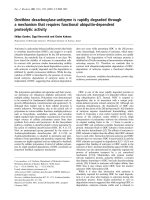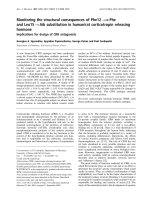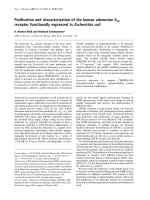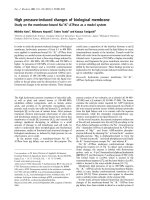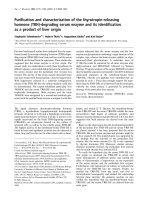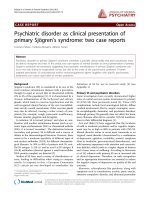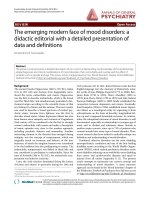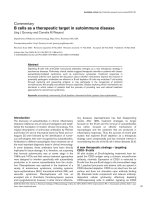Báo cáo y học: "Pre-clinical development as microbicide of zinc tetra-ascorbo-camphorate, a novel terpenoid derivative: Potent in vitro inhibitory activity against both R5- and X4-tropic HIV-1 strains without significant in vivo mucosal toxicity" docx
Bạn đang xem bản rút gọn của tài liệu. Xem và tải ngay bản đầy đủ của tài liệu tại đây (586.4 KB, 11 trang )
AIDS Research and Therapy
BioMed Central
Open Access
Research
Pre-clinical development as microbicide of zinc
tetra-ascorbo-camphorate, a novel terpenoid derivative: Potent in
vitro inhibitory activity against both R5- and X4-tropic HIV-1 strains
without significant in vivo mucosal toxicity
Héla Saïdi†1, Mohammad-Ali Jenabian†1, Bernard Gombert2,
Charlotte Charpentier1, Aurèle Mannarini2 and Laurent Bélec*1
Address: 1Laboratoire de Virologie, Hôpital Européen Georges Pompidou, and Université Paris Descartes (Paris V), Paris, France and 2MGB
Pharma, Nỵmes, France
Email: Héla Saïdi - ; Mohammad-Ali Jenabian - ;
Bernard Gombert - ; Charlotte Charpentier - ;
Aurèle Mannarini - ; Laurent Bélec* -
* Corresponding author †Equal contributors
Published: 3 June 2008
AIDS Research and Therapy 2008, 5:10
doi:10.1186/1742-6405-5-10
Received: 24 January 2008
Accepted: 3 June 2008
This article is available from: />© 2008 Sạdi et al; licensee BioMed Central Ltd.
This is an Open Access article distributed under the terms of the Creative Commons Attribution License ( />which permits unrestricted use, distribution, and reproduction in any medium, provided the original work is properly cited.
Abstract
Background: Terpenoid derivatives originating from many plants species, are interesting
compounds with numerous biological effects, such as anti-HIV-1 activity. The zinc tetra-ascorbocamphorate complex (or "C14"), a new monoterpenoid derivative was evaluated in vitro for its
anti-HIV-1 activity on both R5- and X4-HIV-1 infection of primary target cells (macrophages,
dendritic cells and T cells) and on HIV-1 transfer from dendritic cells to T cells.
Results: The toxicity study was carried out in vitro and also with the New Zealand White rabbit
vaginal irritation model. C14 was found to be no cytotoxic at high concentrations (CC50 > 10 μM)
and showed to be a potential HIV-1 inhibitor of infection of all the primary cells tested (EC50 = 1
μM). No significant changes could be observed in cervicovaginal tissue of rabbit exposed during 10
consecutive days to formulations containing up to 20 μM of C14.
Conclusion: Overall, these preclinical studies suggest that zinc tetra-ascorbo-camphorate
derivative is suitable for further testing as a candidate microbicide to prevent male-to-female
heterosexual acquisition of HIV-1.
Background
Sexual transmission of HIV-1 is predominant worldwide,
and male-to-female transmission during heterosexueal
intercourse is the major way of HIV-1 acquisition in
exposed women, especially in developing countries [1].
Interventions aimed to provide significant changes in sexual behaviour and increased frequency of barrier methods
(male and female condoms) use have not proven their
efficacy to decrease the HIV-1 epidemic in developing
countries [2]. Therefore, new methods of prevention that
can be controlled by women them-self, such as microbicide formulations, are becoming urgently needed. Microbicides may theoretically target the incoming virus at
several steps of molecular events driving viral entry and/or
viral replication. Unlike condoms, they will not create a
physical barrier to intimate contact, nor will they necesPage 1 of 11
(page number not for citation purposes)
AIDS Research and Therapy 2008, 5:10
sarily be contraceptive. The fact that their use will be controlled by women obviously constitutes a very significant
advantage.
Natural products, of which structural diversity is so broad,
are convenient sources for the effective discovery of antiHIV-1 agents with expected lack of cell toxicity [3-5]. Of
these, terpenes, isolated from medicinal plants, have
gained much interest due to their significant anti-HIV-1
activities along with their structural diversity. Betulinic
alcohol (BA) is a pentacyclic triterpene alcohol with a
lupane skeleton. BA is particularly promising because it is
well characterized and can be purified in relatively large
amounts[5,6]. Common structural features of the lupane
skeleton are its five-membered ring and isopropylidene
and it is found predominantly in bushes and trees forming the principal extractive of the bark of birch trees. BA
possesses a wide spectrum of biological and pharmacological activities, such as antimalarial and anti-inflammatory activities[7]. BA and its derivatives have
demonstrated high anti-HIV-1 activity and cytotoxicity
against a variety of tumor cell lines comparable to some
clinically used drugs [8]. Two classes of chemically modified BA derivatives are reported to inhibit HIV-1 replication at nanomolar concentrations, such as PA-457 (class
I) and IC9564 (class II) [7]. Although both classes of BA
derivatives shared the same betulinic acid core, they
exhibit very different modes of anti-HIV-1 action [9]. Previous studies suggested that the molecular mechanism of
action for both classes of BA derivatives were quite unique
in comparison with currently known anti-HIV-1 drugs
that target HIV-1 reverse transcriptase or protease [5].
Overall, based on their site of action, anti-HIV-1 terpenes
could be classified into five groups: 1) entry inhibitors, 2)
reverse transcriptase inhibitors, 3) protease inhibitors, 4)
virus maturation inhibitors that do not inhibit HIV-1 protease and 5) unknown mechanism of action [10]. Notably, these terpenoid derivates are non-toxic up to 500 mg/
kg body weight in mice[6].
The purpose of the present study was to evaluate the first
steps of preclinical development of zinc tetra-ascorbocamphorate (named as "C14"), a novel terpenoid derivative, as potential microbicide molecule. We herein report
that this compound inhibited in vitro efficiently the infection of macrophages, dendritic cells (DC) and T cells.
Standardized animal model was used to examine the
safety and toxicity profiles of C14 derivative. Importantly,
antiviral concentrations of C14 derivative did not result in
detectable levels of inflammation or toxicity in vivo. Our
observations strongly support that microbicide formulation containing zinc tetra-ascorbo-camphorate may represent a powerful candidate microbicide for the prevention
of male-to-female HIV-1 heterosexual transmission.
/>
Materials and methods
Zinc tetra-ascorbo-camphorate derivative
The zinc tetra-ascorbo-camphorate derivative of formula
4(C6H6O6)Zn(C10H14O4) contains a pentacyclic ring
system obtained from a terpene of generic formula
(C5H8)n and 4 ascorbic acids stably linked to an unique
Zn metal. The batch used in present experiment was
named as "C14". C14 was synthesized according to the
following steps: 1) Preparation of a solution of organic
terpenoid acid using a mixture of pure water and alcohol;
2) Reaction of the latter solution with zinc metal salt providing a new terpenoid compound associated with the
metal; 3) Separation, purification and lyophilization of
the resulting metallic compound; 4) Reaction of the
resulting product with ascorbic acid in aqueous solution,
and formation of zinc ascorbo-camphorate; 5) Separation, purification and lyophilization of the resulting product to obtain the pure final derivative in the form of a
powder soluble in water. Synthesis of zinc tetra-ascorbocamphorate derivative is around 10 cents of euro per g.
Reagents
RPMI 1640 (with L-glutamine) and penicillin/streptomycin were provided from Cambrex, Biosciences, Verviers,
Belgium and Invitrogen, Cergy-pontoise, France, respectively. Medium of separation for lymphocytes (MSL) and
fetal calf serum (FCS) were from PAA Laboratories GmbH
(les Mureaux, France), and Eurobio (Les Ulis, France),
respectively. Human recombinant macrophage-colony
stimulating factor (rhM-CSF), granulocyte-colony stimulating factor (rhM-CSF), interleukin-4 (rhIL-4) and interleukin-2 (rhIL-2) were obtained from Peprotech (Rocky
Hill, NJ). Phytohemagglutinin-P (PHA) was from SigmaAldrich (St Louis, MO). T-20, Fusion Inhibitor (DAIDS,
free N and C terminal amino acids) was obtained from the
AIDS Reagent Program, Division of AIDS, NIAID, NIH.
Human polyclonal anti-gp160 antibodies were purified
by immunoaffinity from pooled sera of HIV-1 seropositive individuals [11].
Antibodies
Anti-CD4 mAb (PE-CD4, RPA-T4), anti-CCR5 (PE-CCR5,
2D7), anti-CXCR4 (PE-CXCR4, 12G5), anti-HLA-DR
(FITC-HLA-DR, TU-36), anti-CD14 (PE-CD14, M5E2),
anti-CD16 (FITC-CD16, 3G8) and anti-DC-SIGN (PEDC-SIGN, DCN46) mAbs were obtained from BD
Pharmingen.
Virus stocks
Primary X4-HIV-1NDK was grown in peripheral blood lymphocytes (PBL) of healthy donors stimulated with PHA
and rhIL-2. R5-HIV-1Ba-L was amplified in monocytederived macrophages of healthy donors. Viral stock produced was clarified by centrifugation prior to HIV-1 p24
Page 2 of 11
(page number not for citation purposes)
AIDS Research and Therapy 2008, 5:10
concentration and TCID50 determination: 1 ng of p24
antigen corresponding to 1000 TCID50 [11].
Tropism of viruses was determined using U87 cells transfected with DNA encoding for human CD4 and CCR5 or
CXCR4 (NIH AIDS research and Reference Reagent Program provided by Dr. E. Menue, Institut Pasteur, Paris).
The number of viral particles was assessed by the real time
RT-PCR. Briefly, RNA were isolated from HIV-infected
cells on a silica column system according to the manufacturer's recommendations (Qiagen DNA or RNA minikit,
AG, Basel, Switzerland). HIV-1 RNA quantification was
carried out by RT-PCR using primers (forward: 5'GGCGCCACTGCTAGAGATTTT-3'; reverse: (5'-GCCTCAATAAAGCTTGCCTTGA-3') and exonuclease probe (5'FAM-AAGTAGTGTGTGCCCGTCTGTTRTKTGACTTAMRA-3') designed to amplify a fragment in the long terminal repeat (LTR) gene. Reverse transcription and amplification were achieved in a one step RT-PCR using the
LightCycler-RNA master hybridization probes kit (Roche
Diagnostics Corporation, Mannheim, Germany), as previously described [12]. A standard graph of the Cp values
was obtained from serial dilutions (106 to 10 copies per
assay) of the HIV-1 subtype A strain. Similar concentrations (expressed in copies/ml) of HIV-1Ba-L and HIV-1NDK
solutions stocks were used.
In vitro differentiation of monocyte-derived macrophages
(MDM) and monocyte-derived dendritic cells (MDDC)
PBMC were isolated from buffy coats of healthy adult
donors by Ficoll density gradient centrifugation on MSL,
as previously described [13]. The percentage of monocytes
was determined by flow cytometry using forward scatter
and side scatter properties (FSC/SSC). PBMC were re-suspended in RPMI 1640 medium supplemented with
glutamine, penicillin (100 IU/ml) and streptomycin (100
μg/ml). Cells were seeded into 24 well-plates (Costar,
Cambridge, MA) at the concentration 1 × 106 adherent
cells/ml and incubated at 37°C for 45 minutes. Nonadherent cells were removed by 4 washes. Adherent monocytes were incubated in RPMI medium with 10% FCS,
glutamine, and antibiotics in the presence of 10 ng/ml
rhM-CSF (10 ng/ml) to differentiate to macrophages. The
relative concentration of rhM-CSF improve cell viability
and maintained a neutral environment with respect to
activation marker quantitative expression (HLA-DR,
CD14, CD16), which remained similar to that of MDM
cultured in medium alone. After six days of culture, adherent cells corresponding to the macrophages-enriched fraction were harvested, washed, and used for subsequent
experiments [14]. MDDC are generated from monocytes
in the presence of rhGM-CSF (10 ng/ml) in combination
with rhIL-4 (10 ng/ml). Following six days, MDDC are
semi-adherent cells and expressed high levels of DC-SIGN
but not monocytes/macrophages markers such as CD14
/>
and CD16. The medium, including all supplements, was
replaced the third day of differentiation. Flow cytometry
analysis (CellQuest software) demonstrated that macrophages and DCs were more than 90% pure.
Purification of autologous T lymphocytes
T cells were subsequently prepared from the monocytedepleted cell fraction. Peripheral blood lymphocytes
(PBL) were cultured for 48 hours in fresh medium supplemented with PHA (2.5 μg/ml) and rhIL-2 (1 μg/ml). PBL
were then washed and cultured in growth medium containing rhIL-2 (1 μg/ml) for 24 hours [14].
Phenotypic characterization of MDM or MDDC
Cell surface antigens were analyzed by FACSCalibur (Becton Dickinson, NJ, USA) using monoclonal antibodies
(mAbs) conjugated with either fluorescein isothiocyanate
(FITC) or phyco-erithryn (PE). Following incubation with
different mAbs for 30 min at 4°C, cells were washed with
PBS containing azide (0.01%), BSA (0.2%) and fixed
using 1% formaldehyde PBS buffer.
Inhibition of infection of MDM, MDDC or T cells [13,14]
Cells were washed 2 times after 6 days of differentiation
and seeded into 96-well culture plates (5 × 105 cells/well).
HIV-1 (1 ng p24 antigen/ml) and increasing concentrations of molecules were added on cells and incubated for
3 hours at 37°C in a 5% CO2 atmosphere. Each sample
was performed in triplicate. After 4 washes to remove
exceeding virus, cells were cultured for 3 days. The
amounts of virus replication were monitored by HIV-1
p24 antigen ELISA, so carried out 3 days after exogenous
addition of C14. In this last case, supernatants were harvested and viruses produced were lysed by incubation for
45 minutes at 37°C with 1% Triton X-100.
Extraction and quantification of HIV-1 DNA
Genomic DNA was isolated from HIV-infected macrophages by using extraction protocol on a silica column
system according to the manufacturer's instructions (Qiagen DNA minikit, AG, Basel, Switzerland). HIV-1 DNA
was quantified by using 5' nuclease assay in the LTR gene
and carried out on the LightCycler instrument (Roche
Applied Science), with using the sense primer NEC152
(GCCTCAATAAAGCTTGCCTTGA) and the reverse primer
NEC131 (GGCGCCA CTGCTAGAGATTTT) in the presence of a dually (FAM and TAMRA) labelled NEC LTR
probe
(AAGTAGTGTGTGCCCGTCTGTTRTKTGACT)
(Eurogentec SA, Seraing, Belgium). The LC-PCR master
mix contained 1 × Fast-Start Taq DNA polymerase reaction buffer (Roche Applied Science), 3 mM MgCl2, 0.3 μM
of each primer and probe. Cycling conditions were as follows: initial denaturation/FastStart Taq DNA polymerase
activation at 95°C/10 minutes, 45 cycles of denaturation
at 95°C/10 seconds, annealing and extension at 60°C/30
Page 3 of 11
(page number not for citation purposes)
AIDS Research and Therapy 2008, 5:10
seconds with a ramp of 5°C/seconds. The first PCR cycle
allowing fluorescence detection permitted to quantify
HIV-1 DNA by reference to a standard curve (dilutions of
8E5 cell DNA). All reactions were performed in triplicate
and tested in the same assay. The level of albumin DNA
copies in the cell pellet was used as endogenous reference
to normalize the variations in cells number, as previously
described [15]. The normalized value of cell-associated
HIV-1 DNA loads corresponding to the ratio [(HIV-1 copy
number/albumin copy number) × 2 × 106], was finally
expressed as the number of HIV-1 DNA copies per 106
cells.
Inhibition of MDDC-mediated infection of autologous T
cells [14]
To assess the transmission of HIV-1 from MDDC to autologous T-cells, MDDC were incubated into 96-well culture
plates (105 cells/well) and infected with HIV-1 (1 ng p24)
in the presence of increasing concentrations of molecules
for 3 hours at 37°C in a 5% CO2 atmosphere. Cells were
washed four times and autologous stimulated T cells were
added onto infected MDDC at a MDDC/T-cell ratio of 1/
5 for 6 days. Each sample was performed in triplicate. Culture supernatants were harvested every 3 days and fresh
medium was added. Supernatants were inactivated with
1% Triton X-100. The viral production by T lymphocytes
was evaluated the sixth day of the co-culture by measurement of HIV-1 p24 antigen in supernatants using capture
ELISA.
Cytotoxicity assay
The cytotoxicity of the C14 derivative against primary cells
(MDDC, T cells and MDM) was analysed using the MTT
(3-[4,5-dimethylthiazol-2-yl]-2,5-diphenyl tetrazolium
bromide) assay (Sigma-Aldrich), as previously described
[14]. Briefly, cells were seeded onto 96-well plates at a
density of 2 × 105 cells/well and incubated for 24 hours at
37°C prior to drug exposure. On the day of treatment, culture medium was carefully aspirated from the wells and
replaced with fresh medium containing serial concentrations of C14 derivatives. Triplicate wells were used for
each treatment. The cells were incubated with the various
compounds for 24 hours at 37°C in a humidified 5% CO2
atmosphere. To each well, 20 μl of MTT (0.5 mg/ml final
concentration) was added and the plates were incubated
at 37°C for 4 hours to allow MTT to form formazan crystals by reacting with metabolically active cells. The formazan crystals were solubilized 30 minutes at 37°C in a
solution containing 10% sodium dodecyl sulphate in
0.01 M HCl. The absorbance of each well was measured in
a microtitre reader at 490 nm. To translate the OD490 values into the number of live cells in each well, the OD490
values were compared with those of standard OD490 versus cell number curves generated for each cell type. The
survival index was calculated using the formula:
/>
Survival index = live cell number (test)/live cell number
(control)
Confocal microscopy
Monocytes or PBL (10E5 cells) were adsorbed on a microscopy-adapted slide for 6 days. MDDC, MDM or PBL were
infected in the presence of C14 diluted at 10 μM for 3
hours. Cells were then washed and incubated with or
without polyclonal antibodies anti-gp160 (50 μg/ml) at
4°C for 30 minutes. Cells were washed with PBS 0.01%
azide 0.5% BSA, and were labelled with polyclonal mouse
anti-human IgG-FITC (Jackson ImmunoResearch Laboratories, West Grove, PA, USA) and then fixed with 1% paraformaldehyde. The coverslides were mounted in Mowiol
(Sigma-Aldrich). The observations were made by sequential acquisition with a Zeiss LSM510 System, mounted on
an Axiovert 100 M optical microscope (Carl Zeiss AG,
Oberkochen, Germany), using a planapochromat ×63,
1.4 numerical aperture oil immersion objective. Optical
sections were acquired, each one with an image resolution
of 512 × 512 pixels.
New Zealand White rabbit vaginal irritation study
All procedures for the rabbit irritation study were conducted in referring to French authorities («ISO 10993
standard, version 2002: Biological Evaluation of Medical
Devices, Part 10: Tests for irritation and sensitization»),
and this part of the study was performed by the Biomatech
company (Chasse-sur-Rhone, France) which is certified
according to the European qualification ISO 17025.
Nine nulliparous and nonpregnant female New Zealand
White rabbits were used to determine potential irritation
effects following vaginal application of two C14 formulations. All animals were acclimated for 5 days prior to the
experiment. The animals were categorized into 3 treatment groups, including three rabbits treated with low
dose of C14 (C14 diluted 2000 times in PBS, 1 μM; C14LD), three with high dose of C14 (C14 diluted 100 times
in PBS, 20 μM; C14-HD), and three PBS-treated animals.
The animals received vaginally 1 ml of C14 or PBS per day
for 10 consecutive days. The animals' body weights were
measured daily; and clinical observations were recorded,
including swollen vulva areas, blood-stained urine, and
soft stools. On day 10, all animals were euthanized by
intravenous injection of sodium pentobarbital, in accordance with the guidelines of the American Veterinary Medical Association Panel on Euthanasia. The vaginal tracts
were surgically excised and parts of the upper (cervicovagina), middle (midvagina), and lower (urovagina) areas
of each vagina were fixed with formalin and paraffin
embedded by standard histological examination. To
assess gross tissue morphology, sections were stained with
hematoxylin and eosin. A vaginal irritation grading system with scores from 0 (normal parameter or absent
Page 4 of 11
(page number not for citation purposes)
AIDS Research and Therapy 2008, 5:10
/>
adverse effects) to 4 (most severe adverse findings) was
used to score each formulation for epithelial integrity, epithelial vascular congestion, leukocyte infiltration, and
edema. Composite average scores of 1 to 4 receive a vaginal irritation rating of "minimal," scores of 5 to 8 receive
a vaginal irritation rating of "mild," scores of 9 to 11
receive a vaginal irritation rating of "borderline," and
scores of 12 to 16, receive a vaginal irritation rating of
"unacceptable". Formulations with vaginal irritation ratings between 1 and 8 are considered acceptable for vaginal
application [16].
Statistical analysis
Statistical significance of the treated group mean with that
of control group was analyzed by a 1 way-analysis of variance, followed by Dunnett's multiple comparison test
using GraphPad Prism version 3.0 software (San Diego,
CA). Differences were considered statistically significant if
p < 0.05.
Figure 1
Evaluation of C14 toxicity on primary cells
Evaluation of C14 toxicity on primary cells. Monocytederived macrophages, monocyte-derived dendritic cells and
T cells were cultured with increased concentrations of C14
(ranged from 1 to 12 μM) for 24 hours. After washing, culture viability was determined by using the MTT-cytotoxicity
assay according to the manufacturer's instructions. The values given are the mean viability ± 1 standard deviation of primary cells, expressed in percentage. Means are
representative of 3 independent experiments and assays
were performed in duplicates.
Results
High concentrations of C14 are not toxic in vitro
High concentrations of C14 derivate may be needed to
produce an effective microbicide formulation. Therefore,
the intrinsic toxicity of C14 derivate concentrations up to
5 μM was evaluated by using a colorimetric cell viability
assay. MDM, MDDC and T cells were exposed to serial
concentrations of each C14 derivate ranging from 1 to 12
μM for 24 hours. The viability index, or the fraction of viable cells following microbicide treatment relative to the
fraction of viable mock-exposed cells, was calculated.
Cells treated by a solution of PBS-azide 0.1% were used as
a positive control for toxicity (data not shown). As shown
in Figure 1, C14 demonstrated viability indices of 0.9 to
1.1 at all concentrations tested, which indicated that it was
non-toxic.
thelial and submucosal DCs [17,18]. The amounts of
virus replication were monitored by HIV-1 p24 antigen
ELISA, so carried out 3 days after exogenous addition of
C14. Indeed, successful transfer of virus across epithelial
barriers would result in HIV-1 capture by DC and subsequent transmission to nearby macrophages and CD4 T
cells or dissemination to draining lymph nodes [17]. We
first investigated the effect of C14 on HIV-1 infection of
macrophages, DC and T cells. Therefore, HIV-1 sensitive
cells were incubated with R5-HIV-1Ba-L or X4-HIV-1NDK in
the presence of increasing non-toxic doses of C14 (Table
1). C14 inhibited efficiently the infection of all cell type
tested and whatever the viral strain tested. Enfuviritide (T20) interfere with entry of the HIV-1 virus into cells by
blocking the structural changes necessary for virus to fuse
C14 inhibits HIV-1 infection of primary cells
Predominant HIV-1 target cells at mucosal level include
CD4 T lymphocytes, submucosal macrophages, intraepi-
Table 1: Toxicity and antiviral activity of zinc tetra-ascorbo-camphorate derivative ("C14") on macrophages, dendritic cells and
peripheral blood lymphocytes by using the primary X4-tropic HIV-1NDK and R5-tropic HIV-1Ba-L.
CC50a
Antiviral molecules
IC50b
MΦ
DC
T cells
MΦ*
DC*
T cells*
C14
>10
>10
>10
HIV-1Ba-L
1.3 ± 01
HIV-1NDK
0.02 ± 0.0
HIV-1Ba-L
1.3 ± 0.1
HIV-1NDK
1.8 ± 0.1
HIV-1Ba-L
0.8 ± 0.0
HIV-1NDK
0.7 ± 0.1
Enfuviritid (T20)
>10
>10
>10
0.08 ± 0.1
8 ± 0.5
0.3 ± 0.0
0.8 ± 0.3
0.4 ± 0.2
6.7 ± 0.2
*Mean ± 1 standard deviation
aTerpenoid derivative C14 concentration (μM) that causes 50% cytotoxicity (CC50) on primary cells (MΦ, DC, T cells)
bTerpenoid derivative C14 concentration (μM) that induces 50% infection inhibition (IC50) on primary cells (MΦ, DC, PBL)by primary X4-HIV1NDKor R5-HIV-1Ba-L, expressed as mean ± 1 standard deviation MΦ: Macrophages; DC: Dendritic cells
Page 5 of 11
(page number not for citation purposes)
AIDS Research and Therapy 2008, 5:10
/>
with CD4+ cell membrane and inhibiting then fusion of
viral and cellular membranes, which served as positive
control in our tests evaluating the inhibitory activity of
C14. Conversely to T-20, much lower doses of C14 were
needed to inhibit more efficiently the infection of macrophages and T cells by X4 virus.
To study the antiviral activity of C14 on HIV-1 transfer
from DC to T cells, DC were pre-treated with C14 followed by addition of cell-free HIV-1. After infection, cultures were washed and co-cultured with autologous CD4
T cells, without C14, and half of the culture supernatant
was refreshed twice weekly with culture medium without
compound. Culture supernatants were harvested after 7 of
culture for measurement of HIV p24 antigen. At 1 μM,
C14 inhibited about 95% both the transfer of R5- and X4tropic HIV-1 (data not shown).
HIV-1 DNA content of C14-treated cells is very low
In vivo, macrophages, DC and CD4 T cells are described to
be major reservoir of HIV-1 [19]. Cells were incubated
with R5-HIV-1Ba-L or X4-HIV-1NDK in the presence of
increasing doses of C14. The HIV-1 DNA content was
quantified precisely with a optimised and randomised
method of real time PCR. As depicted in Figure 2, we
observed a reduction between 2–3 log of the HIV-1 DNA
content in all primary cells and whatever the viral strain
used. FACSCalibur analysis revealed that the cell surface
expressions of CD4, CXCR4 and CCR5 on the primary
cells we used were not altered by their treatment with the
C14 compound (data not shown). Thus, the observed
reduction of HIV-1 proviral DNA levels within C14treated cells was not due to the effect of C14 on cellular
expression of HIV-1 receptors and co-receptors, but rather
the direct effect of C14 on the integrity of viral particles or
the inhibition of viral entry.
In a first approach, we determined whether C14 could disrupt HIV-1 particles leading to an inactivation of HIV-1
particles infectiousness. HIV-1 was thus adsorbed on
poly-L-lysin pre-coated wells and further incubated with
or without C14. To assess the infectiousness of these C14
treated-HIV-1 particles, activated PBL, well known producers of high levels of HIV-1 [20], were incubated with
C14-treated or untreated HIV-1 particles. The levels of R5tropic HIV-1Ba-L production by activated PBL were similar
in wells containing cells co-cultured with virus treated or
untreated with C14 (Figure 3). However, at high concentrations (20 μM), C14 was able to disrupt 58 ± 2% of X4tropic HIV-1 and not R5-tropic HIV-1 particles. As
expected, no viral production was detected in control
wells containing triton X100-treated HIV-1 and activated
PBL (negative control).
Figure 2
into primary C14
Evaluation of cells inhibitory activity on HIV-1 DNA content
Evaluation of C14 inhibitory activity on HIV-1 DNA
content into primary cells. Monocyte-derived macrophages (A), monocyte-derived dendritic cells (B) and T cells
(C) were incubated with R5 or X4 viruses in the presence of
increasing concentrations of C14 or an unique dose of T 20
(5 μM) for 3 hours at 37°C. Cells were then washed and cultured in fresh medium for 3 days. DNA was extracted and
the viral DNA was quantified by real time PCR. Means are
representative of 3 independent experiments and assays
were performed in triplicates. *, p ≤ 0.05; **, p ≤ 0.01
between untreated and treated cells.
We determined further whether C14 could inhibit the
entry of viruses into primary macrophages, DC and T cells
(Figure 4). Cells were incubated with R5-tropic HIV-1Ba-L
in the presence of 1 μM of C14 for 3 hours. After several
washes, cells were incubated with polyclonal antibodies
anti-gp160 purified from HIV-infected patients and then
with anti-human IgG-FITC mouse antibodies. As
observed by immunofluorescence confocal laser micros-
Page 6 of 11
(page number not for citation purposes)
AIDS Research and Therapy 2008, 5:10
/>
Figure 3
Evaluation of C14 capability to limit the infectiousness of viral particles
Evaluation of C14 capability to limit the infectiousness of viral particles. HIV-1 was adsorbed on poly-L-lysin precoated wells (Greiner Bio-One) at 4°C overnight and further incubated with C14 for 1 h. In positive and negative control wells,
1% Triton X-100 and medium were added, respectively. After four washes, activated peripheral blood lymphocytes were incubated with C14 or triton-treated or untreated HIV-1 particles. After 6 days, viral production was assessed by p24 Ag capture
ELISA. Means are representative of 3 independent experiments were performed in triplicates. **, p ≤ 0.01.
copy, C14 inhibited the entry of viruses only into T cells,
unlike in macrophages and DCs.
Taken together, these data strongly suggest that C14 could
alter the infectiousness of viruses, inhibiting the entry of
viruses into T cells and interfering with the HIV-1 reverse
transcriptase activity.
C14 derivative does not cause significant cervicovaginal
inflammation or general toxic effects
The New Zealand White rabbit model was used to assess
whether repeated applications of C14 derivate resulted in
vaginal irritation. Animals were treated with 1 ml of PBS
dilution of C14 containing either low dose (1 μM; C14LD) or high dose (20 μM; C14-HD) of the compound.
Animals treated with PBS alone were included as a reference control. These animals that did not receive compound were subjected to the same technical application
protocol as the treated animals. All animals received daily
intravaginal doses of C14 for 10 consecutive days.
Twenty-four hours after the last application of the test articles, the vaginal tracts were excised from all animals and
processed for histopathological evaluation. There was no
mortality, and no vaginal discharge, erythema or edema
were noted during the study in rabbits injected with the
test solutions. As expected, PBS-treated animals exhibited
normal tissue morphology and staining profiles. The vaginal tissues taken from animals treated with C14-LD or
C14-HD showed some polymorphonuclear cell infiltration in the epithelial and sub-epithelial connective tissue.
Page 7 of 11
(page number not for citation purposes)
AIDS Research and Therapy 2008, 5:10
/>
Figure 4
Evaluation of C14 efficiency to inhibit limit the entry of HIV-1 into primary cells
Evaluation of C14 efficiency to inhibit limit the entry of HIV-1 into primary cells. Monocyte-derived macrophages,
monocyte-derived dendritic cells and T cells were incubated with R5 viruses in the presence of increasing concentrations of
C14 for 3 hours at 37°C. Cells were then washed and incubated with polyclonal human anti-gp160 antibodies. The staining was
revealed with FITC-conjugated mouse anti-human IgG mAbs. Cells were then analysed by confocal microscopy. The experiment was performed 3 times with cells from three different donors. 30 cells were at least analyzed for each donor.
However, the infiltration observed and vascular congestion was not general and was graded as "minimal" and
edema could not be observed (Table 2) (Figures 5A and
5B). The vaginal epithelium remained quite intact (Figures 5A, 5B and 5C), and in two rabbits treated with C14HD, local minimal erosion of the mucosal surface was
noted (Figure 5D). Squamous metaplasia and focal erosion were occasionally observed with a degree of leukocyte infiltration primarily in the sub-epithelial connective
tissues. No necrosis or vascular thrombi were observed in
any animals during this study. Standardized microscopic
evaluation criteria were used to assign a composite average score for each test formulation. The means of vaginal
irritation index for each of the test groups were as follows:
C14-HD-treated group, 2.4 and C14-LD-treated group,
2.1; PBS-treated control, 0.2 (Table 2).
Discussion
In the present study, the zinc tetra-ascorbo-camphorate
complex, a new monoterpenoid derivative, was evaluated
in vitro for its anti-HIV-1 activity on both R5- and X4tropic HIV-1 infection of primary target cell (macrophages, DC and T cells) and on HIV-1 transfer from DC to
T cells, and for its potential toxicity for the vaginal mucosa
using the normalized rabbit vaginal irritation assay. Thus,
the C14 compound used in the study showed potent HIV1 inhibitor with IC50 of 1 μM in the different primary
cells, and was also able to inhibit the transfer of HIV-1
from MDDC to autologous CD4+ T lymphocytes. In addition, the compound was found to be no cytotoxic at high
concentrations (CC50 > 10 μM) and lack of significant
inflammation and adverse changes could be observed in
rabbit cervico-vaginal tissue integrity after repeated exposure during 10 days to formulations containing up to 20
μM of C14. Taken together, our preclinical studies demonstrate that the zinc tetra-ascorbo-camphorate derivative
harbours potent anti-HIV-1 activity in vitro without a significant in vivo mucosal toxicity, and thus may be suitable
for further steps of microbicide development, according
to the guidelines proposed by the «International Working
Group on Microbicide»[21].
In our assays, C14 showed a powerful anti-HIV-1 activity
depending on its concentrations. At concentration less
than 1 μM, C14 inhibited in vitro the infection of macrophages, DC and T cells that are the first cells targeted by
HIV-1 in vivo. Interestingly, at low concentrations, C14
inhibited more than 90% of both R5- and X4-tropic HIV1 transfer from DC to autologous T cells, a mechanism
responsible of the dissemination of the virus from the
mucosal site of its penetration [22,23]. At elevated concentrations (higher than 10 μM), C14 seems to disrupt the
integrity of virus particles, but at non-toxic concentrations, C14 derivate inhibited HIV-1 entry only into T cells
Page 8 of 11
(page number not for citation purposes)
AIDS Research and Therapy 2008, 5:10
/>
Table 2: Scores of epithelium irritation, leucocytes infiltration, vascular congestion and edeme, and vaginal irritation index obtained in
three groups of New Zealand White rabbits traited vaginally during 10 days by low (1 μM; C14-LD) or high doses (20 μM; C14-HD) of
zinc tetra-ascorbo-camphorate derivative (C14), or by PBS (negative controls).
C14-HD*
Epithelium (0–4)£
Infiltration of leucocytes (0–4)£
Vascular congestion (0–4)£
Edeme (0–4)£
Vaginal irritation index (0–16)$
C14-LD*
PBS*
1.560 ± 1.667
0.556 ± 0.880
0.444 ± 1.330
0
2.4
0.889 ± 1.270
0.444 ± 0.520
0.778 ± 1.394
0
2.1
0
0.222 ± 0.440
0
0
0.2
* Mean ± 1 standard deviation
£ The scores for epithelium irritation, leucocytes infiltration, vascular congestion and oedeme, were calculated as the mean of the scores estimated
at the cervicovagina, midvagina and urovagina of the 3 rabbits in each group. The final score is then expressed as mean ± 1 standard deviation of 9
determinations.
$ The mean vaginal irritation index corresponds to the addition of the scores of epithelium irritation, leucocytes infiltration, vascular congestion
and edeme, as adapted from the norme "ISO 10993 standard, version 2002: Biological Evaluation of Medical Devices, Part 10: Tests for Irritation
and Sensitization". Interpretation of the vaginal irritation index is as follows: 0: None; 1: Minimal; 2: Mild; 3: Moderate; 4: Intense. The correlations
with human irritation potential are as follows: Vaginal irritation index < 8: Acceptable; 9–10: Marginal; and ≥ 11: Unacceptable, according to Eckstein
and colleagues (Eckstein et al., 1969).
and not into macrophages and DC, and decreased dramatically DNA proviral quantity by 1 to 3 log10 into all
primary cells tested, suggesting that its antiviral activity is
mostly due to its capacity to inhibit the entry of HIV-1
into T cells and may limit the reverse transcription step
into macrophages and DC. These findings indicate that
C14 harbours potent HIV-1 entry inhibition activity and/
or targets pre-integrative step of viral cycle. Further work is
needed to determine precisely the molecular mechanism
of action of C14.
We have showed that the C14 compound was also able to
inhibit the transfer of HIV-1 from MDDC to autologous
CD4 T lymphocytes. In our experimental conditions, HIV1 was transferred from MDDC towards T cells by mechanisms in trans [22] and in cis [24]. In addition, C14 dramatically decreased the infection of DCs. Since viruses
produced by DCs (excluding virions captured and transferred in trans by a mechanism DC-SIGN-dependent) may
be efficiently transferred from DCs to T cells [24], the
observed decrease of HIV-1 transfer from DCs to T cells in
the presence of C14 may result from reduced efficiency of
C14-treated DCs to produce viruses. We cannot however
exclude in our assay that C14 might alter immune function of DCs, which in turn may lead to a decrease in HIV1 transfer to T cells.
model. Eckstein and colleagues reported that the rabbit
vaginal test is slightly more sensitive that the monkey test
and more closely reflects the likely clinical condition in
humans [16]. Importantly, the rabbit test is also quicker,
cheaper and more easily carried out and interpreted [16].
Notably, this model system is an advised in vivo assay for
all candidate vaginal microbicides advancing into clinical
trials [21]. Conversely to the nonoxynol-9 that have vaginal toxicity with a score of histological changes in the New
Zealand White rabbit of about 8 ± 3 [27], C14 showed
vaginal irritation indexes within ranges indicating that
this compound may be likely suitable for vaginal use in
humans [28,29].
Conclusion
In conclusion, the high anti-HIV-1 activity, and excellent
safety profile and low cost production of the zinc tetraascorbo-camphorate complex evaluated in our preclinical
study provides strong support for the advancement of C14
as a vaginal microbicide. Further studies should include
validation of C14 activity in the macaque model of experimental transmission of SIVmac251 after vaginal deposition [21] and phases I and II in focussing on tolerance in
women [30].
Competing interests
The authors declare that they have no competing interests.
The cytotoxicity for host primary cells of a non-specific
anti-HIV-1 compound is a major issue. Indeed, the nonoxynol-9, a non-specific surfactant, which destroys HIV-1
particles in vitro [25], caused lesions in the vaginal epithelium in vivo and increased the probability of being
infected with HIV-1 [26]. To assess whether biological
activity of C14 causes inflammation or irritation which
could subsequently promote infection, we used the standardized New Zealand White rabbit vaginal irritation
Authors' contributions
HS and MAJ carried out differentiation and infection of
dendritic cells, macrophages and T cells, isolation of T
cells, HIV-1 transfer assays, cytotoxicity assay, confocal
microscopy assay, interpretation rabbit vaginal irritation
model and helped draft the manuscript. CC carried out
the extraction and quantification of HIV-1 DNA and p24
ELISA. BG and AM provided C14, participated in the
Page 9 of 11
(page number not for citation purposes)
AIDS Research and Therapy 2008, 5:10
/>
5.
6.
7.
8.
9.
10.
11.
Effects of low and mucosa in the New Zealand20 μM) of C14
Figure
model 5
on cervicovaginal high concentrations (1 and White rabbit
Effects of low and high concentrations (1 and 20 μM)
of C14 on cervicovaginal mucosa in the New Zealand
White rabbit model. Rabbit cervicovaginal epithelium was
treated with 1 or 20 μM of C14. The vaginal tracts were surgically excised, formalin fixed, and paraffin embedded by
standard histological protocols. To assess gross tissue morphology, sections were stained with hematoxylin and eosin.
(A) Normal histopathological aspect of the mucosal epithelium of the rabbit #436 that was treated with C14 (1 μM) for
10 days (× 300). (B) Vascular congestion of the mucosal epithelium of the rabbit #435 that was treated with C14 (20
μM) for 10 days (× 300). (C) Vascular congestion of the
mucosal epithelium of the rabbit #436 that was treated with
C14 (1 μM) for 10 days (× 100). (D) Erosion of the mucosal
epithelium of the rabbit #432 that was treated with C14 (20
μM) for 10 days (× 300).
12.
13.
14.
15.
16.
17.
design of the study, and helped draft the manuscript. LB:
conceived the study, participated in its design and coordination. All authors read and approved the final manuscript.
18.
19.
Acknowledgements
20.
We gratefully acknowledge Christophe Klein for technical assistance. This
work was supported by the Association pour la Recherche en Infectiologie
(ARI), Paris, France. H.S was recipient of grant from European Commission
(VIth framework, project EMPRO Contract no. 503558).
21.
References
1.
2.
3.
4.
Türmen T: Gender and HIV/AIDS. Int J Gynaecol Obstet 2003,
82(3):411-8.
Pool R, Hart G, Green G, Harrison S, Nyanzi S, Whitworth J: Men's
attitudes to condoms and female controlled means of protection against HIV and STDs in south-western Uganda. Cult
Health Sex 2000, 2(2):197-211.
Lee-Huang S, Huang PL, Huang PL, Bourinbaiar AS, Chen HC, Kung
HF: Inhibition of the integrase of human immunodeficiency
virus (HIV) type 1 by anti-HIV plant proteins MAP30 and
GAP31. Proc Natl Acad Sci USA 1995, 92:8818-22.
Mlinaric A, Kreft S, Umek A, Strukelj B: Screening of selected
plant extracts for in vitro inhibitory activity on HIV-1 reverse
transcriptase (HIV-1 RT). Pharmazie 2000, 55:75-7.
22.
23.
24.
Yu D, Morris-Natschke SL, Lee KH: New developments in natural products-based anti-AIDS research. Med Res Rev 2007,
27:108-32.
Alakurtti S, Makela T, Koskimies S, Yli-Kauhaluoma J: Pharmacological properties of the ubiquitous natural product betulin. Eur
J Pharm Sci 2006, 29:1-13.
Yogeeswari P, Sriram D: Betulinic acid and its derivatives: a
review on their biological properties. Curr Med Chem 2005,
12:657-66.
Tsuda H, Okamoto H: Elimination of metabolic cooperation by
glycyrrhetinic acid, an anti-tumor promoter, in cultured Chinese hamster cells. Carcinogenesis 2005, 7(11):1805-7.
Cichewicz RH, Kouzi SA: Chemistry, biological activity, and
chemotherapeutic potential of betulinic acid for the prevention and treatment of cancer and HIV infection. Med Res Rev
2004, 24:90-114.
Huang L, Chen CH: Molecular targets of anti-HIV-1 triterpenes. Curr Drug Targets Infect Disord 2002, 2(1):33-6.
Chomont N, Hocini H, Gody JC, Bouhlal H, Becquart P, Krief-Bouillet
C, Kazatchkine M, Bélec L: Neutralizing monoclonal antibodies
to human immunodeficiency virus type 1 do not inhibit viral
transcytosis through mucosal epithelial cells. Virology 2008,
20;370(2):246-54.
Legoff J, Bouhlal H, Grésenguet G, Weiss H, Khonde N, Hocini H,
Désiré N, Si-Mohamed A, de Dieu Longo J, Chemin C, Frost E, Pépin
J, Malkin JE, Mayaud P, Bélec L: Real-time PCR quantification of
genital shedding of herpes simplex virus (HSV) and human
immunodeficiency virus (HIV) in women coinfected with
HSV and HIV. J Clin Microbiol 2006, 44(2):42.
Saïdi H, Magri G, Carbonneil C, Nasreddine N, Réquena M, Bélec L:
IFN-gamma-activated monocytes weakly produce HIV-1 but
induce the recruitment of HIV-sensitive T cells and enhance
the viral production by these recruited T cells. J Leukoc Biol
2007, 81(3):642-53.
Saïdi H, Nasreddine N, Jenabian MA, Lecerf M, Schols D, Krief C, Balzarini J, Bélec L: Differential in vitro inhibitory activity against
HIV-1 of alpha-(1–3)- and alpha-(1–6)-D-mannose specific
plant lectins: implication for microbicide development. J
Transl Med 2007, 5:28.
Laurendeau I, Bahuau M, Vodovar N, Larramendy C, Olivi M, Bieche
I, Vidaud M, Vidaud D: TaqMan PCR-based gene dosage assay
for predictive testing in individuals from a cancer family with
INK4 locus haploinsufficiency. Clin Chem 1999, 45:982-6.
Eckstein P, Jackson MC, Millman N, Sobrero AJ: Comparison of
vaginal tolerance tests of spermicidal preparations in rabbits
and monkeys. J Reprod Fertil 1969, 20(1):85-93.
Haywood AM: Virus receptors: binding, adhesion strengthening, and changes in viral structure. J Virol 1994, 68:1-5.
Hladik F, Sakchalathorn P, Ballweber L, Lentz G, Fialkow M, Eschenbach D, McElrath MJ: Initial events in establishing vaginal entry
and infection by human immunodeficiency virus type-1.
Immunity 2007, 26(2):257-70.
Miller CJ, Shattock RJ: Target cells in vaginal HIV transmission.
Microbes Infect 2003, 5(1):59-67.
Schnittman SM, Lane HC, Greenhouse J, Justement JS, Baseler M,
Fauci AS: Preferential infection of CD4+ memory T cells by
human immunodeficiency virus type 1: evidence for a role in
the selective T-cell functional defects observed in infected
individuals. Proc Natl Acad Sci USA 1990, 87:6058-62.
Lard-Whiteford SL, Matecka D, O'Rear JJ, Yuen IS, Litterst C,
Reichelderfer P: Recommendations for the nonclinical development of topical microbicides for prevention of HIV transmission: an update. J Acquir Immune Defic Syndr 2004, 36:541-52.
Geijtenbeek TB, Kwon DS, Torensma R, van Vliet SJ, van Duijnhoven
GC, Middel J, Cornelissen IL, Nottet HS, KewalRamani VN, Littman
DR, Figdor CG, van Kooyk Y: DC-SIGN, a dendritic cell-specific
HIV-1-binding protein that enhances trans-infection of T
cells. Cell 2000, 100:587-97.
Turville SG, Vermeire K, Balzarini J, Schols D: Sugar-binding proteins potently inhibit dendritic cell human immunodeficiency virus type 1 (HIV-1) infection and dendritic-celldirected HIV-1 transfer. J Virol 2005, 79:13519-27.
Burleigh L, Lozach PY, Schiffer C, Staropoli I, Pezo V, Porrot F,
Canque B, Virelizier JL, Arenzana-Seisdedos F, Amara A: Infection of
dendritic cells (DCs), not DC-SIGN-mediated internaliza-
Page 10 of 11
(page number not for citation purposes)
AIDS Research and Therapy 2008, 5:10
25.
26.
27.
28.
29.
30.
/>
tion of human immunodeficiency virus, is required for longterm transfer of virus to T cells. J Virol 2006, 80(6):2949-57.
Polsky B, Baron PA, Gold JW, Smith JL, Jensen RH, Armstrong D: In
vitro inactivation of HIV-1 by contraceptive sponge containing nonoxynol-9. Lancet 1988, 1:1456.
Van Damme L, Ramjee G, Alary M, Vuylsteke B, Chandeying V, Rees
H, Sirivongrangson P, Mukenge-Tshibaka L, Ettiegne-Traore V, Uaheowitchai C, Karim SS, Masse B, Perriens J, Laga M: Effectiveness of
COL-1492, a nonoxynol-9 vaginal gel, on HIV-1 transmission
in female sex workers: a randomised controlled trial. Lancet
2002, 360:971-7.
D'Cruz OJ, Uckun FM: Intravaginal toxicity studies of a gelmicroemulsion formulation of spermicidal vanadocenes in
rabbits. Toxicol Appl Pharmacol 2001, 170(2):104-12.
Fichorova RN: Guiding the vaginal microbicide trials with
biomarkers of inflammation. J Acquir Immune Defic Syndr 2004,
37(Suppl 3):S184-93.
Kish-Catalone TM, Lu W, Gallo RC, DeVico AL: Preclinical evaluation of synthetic -2 RANTES as a candidate vaginal microbicide to target CCR5. Antimicrob Agents Chemother 2006,
50:1497-509.
Mauck C, Rosenberg Z, Van Damme L, International Working Group
on Microbicides: Recommendations for the clinical development of topical microbicides: an update.
AIDS 2001,
4;15(7):857-68.
Publish with Bio Med Central and every
scientist can read your work free of charge
"BioMed Central will be the most significant development for
disseminating the results of biomedical researc h in our lifetime."
Sir Paul Nurse, Cancer Research UK
Your research papers will be:
available free of charge to the entire biomedical community
peer reviewed and published immediately upon acceptance
cited in PubMed and archived on PubMed Central
yours — you keep the copyright
BioMedcentral
Submit your manuscript here:
/>
Page 11 of 11
(page number not for citation purposes)
